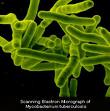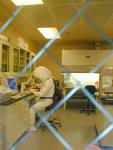World TB Day Is on March 22 (Are We Failing 1/3 of the World's Population?)
 If this were a blog about HIV or Malaria, I could write about the advances that we have seen in the past year. Alas, this is just a blog about tuberculosis - a disease as old as humanity that we have not yet been able to tame. One third of the world's population is infected with tuberculosis. Clearly, much more remains to be done for Haiti and for the world.
If this were a blog about HIV or Malaria, I could write about the advances that we have seen in the past year. Alas, this is just a blog about tuberculosis - a disease as old as humanity that we have not yet been able to tame. One third of the world's population is infected with tuberculosis. Clearly, much more remains to be done for Haiti and for the world.

Good data on TB is hard to come by. Looking back to 2006, the World Health Organization estimates that there were more than 9 million new TB cases and close to 1.7 million deaths from TB worldwide. This represents a a slow decline from 2003 and both global prevalence and global death rates have gone done slightly. That is somewhat good news. However, drug resistant TB and coinfection with both HIV and TB represent serious challenges. For every five TB cases diagnosed globally in 2006, four went undetected. The WHO indicates case detection slowed globally in 2006 and began to stall in China and India.
 When we talk about a case of TB we are talking about a human being. Who were the 9 million individuals newly infected with TB in 2006. This is not a disease of the rich. Those who were infected were mostly poor, undernourished, living in crowded conditions, and possibly infected with HIV or another disease that compromised their immune systems and made them vulnerable to TB infection.
When we talk about a case of TB we are talking about a human being. Who were the 9 million individuals newly infected with TB in 2006. This is not a disease of the rich. Those who were infected were mostly poor, undernourished, living in crowded conditions, and possibly infected with HIV or another disease that compromised their immune systems and made them vulnerable to TB infection.
 Decades ago, we had thought that TB had been beat. We were wrong. In the wake of the HIV pandemic, TB has made a resurgence. When we talk about the war against TB, we are also talking about the war against HIV.
Decades ago, we had thought that TB had been beat. We were wrong. In the wake of the HIV pandemic, TB has made a resurgence. When we talk about the war against TB, we are also talking about the war against HIV.
 As a result of this poor planning, the only vaccine we have for TB is the BCG - which not very effective. There are improved vaccine candidates but it will be years of clinical trials before we know which ones are promising and which should be abandoned. The drugs we use to treat the disease are sorely outdated. Should you become infected with TB and opt for treatment, you will be taking medication daily for approximately eight months. If you have a normal strain of TB, treatment will not be very expensive. Should you have a drug resistant strain, the cost of curing you will easily bein the tens of thousands of dollars.
As a result of this poor planning, the only vaccine we have for TB is the BCG - which not very effective. There are improved vaccine candidates but it will be years of clinical trials before we know which ones are promising and which should be abandoned. The drugs we use to treat the disease are sorely outdated. Should you become infected with TB and opt for treatment, you will be taking medication daily for approximately eight months. If you have a normal strain of TB, treatment will not be very expensive. Should you have a drug resistant strain, the cost of curing you will easily bein the tens of thousands of dollars.
 Most cases of TB infection occur in Sub-Saharan Africa and Southeast Asia. It is also a problem in Haiti. Records indicate that there were 28,209 new infections in Haiti for 2006. For every 100,000 Haitians 402 are infected with TB.
Most cases of TB infection occur in Sub-Saharan Africa and Southeast Asia. It is also a problem in Haiti. Records indicate that there were 28,209 new infections in Haiti for 2006. For every 100,000 Haitians 402 are infected with TB.
 A bright spot is that access to Directly Observed Treatment Short Course, or DOTS, continues to expand in Haiti and around the world. Tailored for low resource settings and developed considerably in Haiti, the approach is community based, effective and inexpensive. Health agents stop by the homes of the patients each day to observe them taking their meds. If something has prevented him/her from taking the meds (for example a family emergency), the health agent helps the patient resolve the problem and then observes the medication being taken. This approach is instrumental to helping communities take ownership over fighting tuberculosis (as opposed to expecting a client to come to a clinic each day which has been proven ineffective).
A bright spot is that access to Directly Observed Treatment Short Course, or DOTS, continues to expand in Haiti and around the world. Tailored for low resource settings and developed considerably in Haiti, the approach is community based, effective and inexpensive. Health agents stop by the homes of the patients each day to observe them taking their meds. If something has prevented him/her from taking the meds (for example a family emergency), the health agent helps the patient resolve the problem and then observes the medication being taken. This approach is instrumental to helping communities take ownership over fighting tuberculosis (as opposed to expecting a client to come to a clinic each day which has been proven ineffective).
WHO reports that 184 countries were implementing the DOTS strategy in 2006 and 93% of the world’s population was living in areas where DOTS was in place. The average success rate for DOTS treatment was nearly 85% in 2005.
 A bright spot is that more resources have become available for the fight against TB. The Global Fund to Fight HIV/AIDS, TB, and Malaria is financing, through donor contributions, programs which have detected 5 million additional cases of TB, cured 3 million people through DOTS, and treated 24,000 cases of drug resistant TB. Still, more financial support is needed from both national governments and the international community alike particularly when it comes to treating drug resistant cases.
A bright spot is that more resources have become available for the fight against TB. The Global Fund to Fight HIV/AIDS, TB, and Malaria is financing, through donor contributions, programs which have detected 5 million additional cases of TB, cured 3 million people through DOTS, and treated 24,000 cases of drug resistant TB. Still, more financial support is needed from both national governments and the international community alike particularly when it comes to treating drug resistant cases.
 Another important initiative is the President's Emergency Plan for AIDS Relief (PEPFAR). During its first five years, PEPFAR provided over fifteen billion dollars in U.S. support for HIV/AIDS programming, some of which went to treating TB. It is the largest health initiative concentrating on a single disease. Indications are that PEPFAR will receive 50 billion dollars of funding for its next five years of programming. This will make more resources available for combatting tuberculosis especially with HIV infected populations.
Another important initiative is the President's Emergency Plan for AIDS Relief (PEPFAR). During its first five years, PEPFAR provided over fifteen billion dollars in U.S. support for HIV/AIDS programming, some of which went to treating TB. It is the largest health initiative concentrating on a single disease. Indications are that PEPFAR will receive 50 billion dollars of funding for its next five years of programming. This will make more resources available for combatting tuberculosis especially with HIV infected populations.
 Drug resistance is enemy number one. When patients don't complete the full course, drug resistance can result which is harder and more expensive to treat. We have a model of treatment that works very well in DOTS. The international community must continue to expand the model to ensure that everyone who needs it, regardless of income level or whether they live in a slum or the countryside, has access to it.
Drug resistance is enemy number one. When patients don't complete the full course, drug resistance can result which is harder and more expensive to treat. We have a model of treatment that works very well in DOTS. The international community must continue to expand the model to ensure that everyone who needs it, regardless of income level or whether they live in a slum or the countryside, has access to it.
 Health systems need to be strengthened across the board. This will benefit not just treatment for TB but for other diseases as well. As TB is a problem not just of individuals but of families and ultimately communities - communities should be empowered to understand what TB is, how it is treated, and what happens when the full course is not completed. The DOTS approach is key to destimgatizing TB and should be coupled with strong educational programs.
Health systems need to be strengthened across the board. This will benefit not just treatment for TB but for other diseases as well. As TB is a problem not just of individuals but of families and ultimately communities - communities should be empowered to understand what TB is, how it is treated, and what happens when the full course is not completed. The DOTS approach is key to destimgatizing TB and should be coupled with strong educational programs.
If you would like to learn more about TB, view this list of frequently asked questions. For a very in depth view of the state of TB in the world, take a look at the World Health Organization 2008 TB Report.
I hope that when World TB Day comes next year, I will be able to say that we have made more progress than we have thus far. The sake of one third of the World's population depends on this.
Bryan
Add new comment